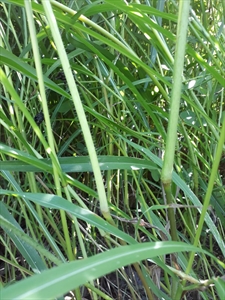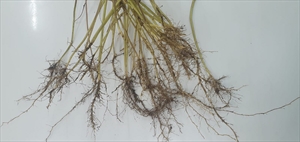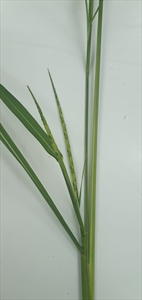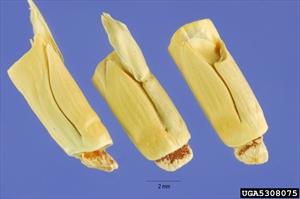- Widespread. Asia, Africa, North, South and Central America, Caribbean, Oceania. In Australia, Fiji, PNG, Solomon Islands.
- Aggressive grass of open, well-drained sites, along roads, railways, but also wet places, including shallow water. Invasive in soybean, corn, cotton, peanut, upland rice, sugarcane. Plants produce many thousands of seeds, and thrive under a range of environmental conditions. Alternative host for maize viruses (Maize mosaic nucleorhabdovirus; see Fact Sheet no. 074). Hairs damage skin.
- Stems, cylindrical, hollow, branching at upper nodes, with basal prop roots, and multiple tillers. Leaves, blue-green, 5-20 mm wide, with conspicuous pale mid-vein. Silica hairs on leaf sheath cause the itch. Flowers, on spikes, up to 15 cm long, single or in groups of 3-4, arising from leaf axils at top of the stem. As spikes mature, the cylindrical rice-size seeds progressively break free starting at furthest end.
- Spread: seeds, by birds, floodwater, rodents, farm machinery; along transport routes; contaminant of rice and legume seed.
- Biosecurity: high risk of introduction; one of the 12 worst weeds of sugarcane, and a competitive weed of maize. On Global Invasive Species Database of alien invasive species (IUCN, 2020).
- Biocontrol: several fungi have potential as mycoherbicides.
- Cultural control: hand weed; slashing; cultivation (plus use herbicide); interplant food legumes with maize; vehicle hygiene; IPM - fire, plough, fallow.
- Chemical control: in Australia: hexazinone + diuron. In Fiji, glyphosate; diuron.












